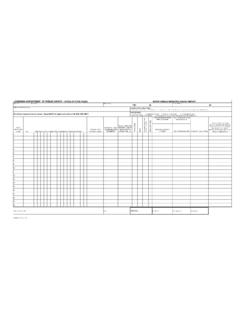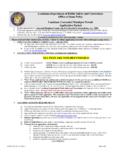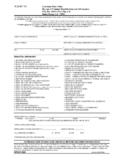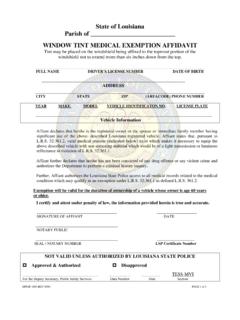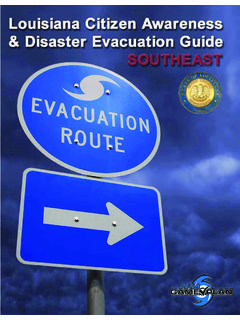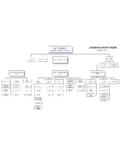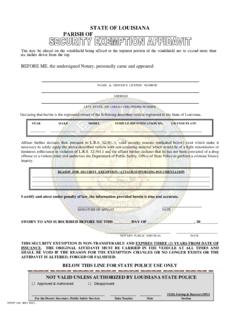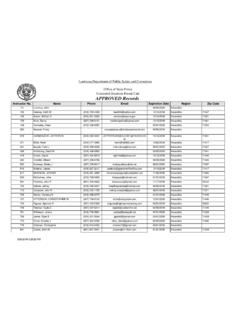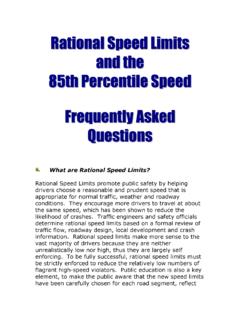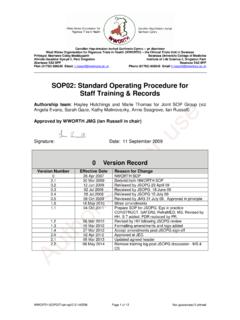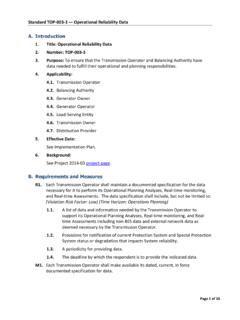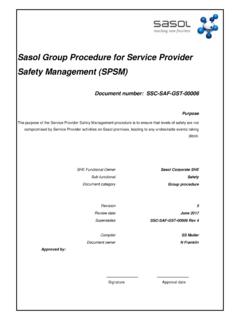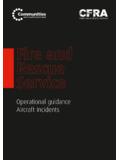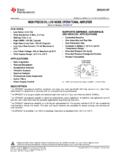Transcription of STATE OF LOUISIANA JOINT STANDARD …
1 STATE OF LOUISIANA JOINT STANDARD operating PROCEDURE STATEWIDE CREDENTIALING / ACCESS CONTROL PROGRAM ALL HAZARDS REENTRY AND TRANSIT Effective July 25, 2011 JOINT STANDARD operating PROCEDURE ALL HAZARDS REENTRY AND TRANSIT STATE OF LOUISIANA PAGE 2 OF 25 [PUB DATE] Table of Contents 1. Introduction ..4 Overview .. 4 Purpose .. 4 Scope / Applicability .. 5 Administrative Provisions .. 6 2. Concept of Operations ..7 Unified Phased Reentry Protocol .. 7 Tier ER Immediate / Unrestricted Access (Color Code = Red) .. 7 Tier 1 Response Support (Color Code = Blue) .. 8 Tier 2 Recovery Support (Color Code = Green) .. 8 Tier 3 Rebuild / Repopulate (Color Code = Grey) .. 8 Partial Evacuation Reentry for CBRNE .. 8 Identification / Credentialing Guidelines .. 9 Disaster / Incident Preparations .. 9 Checkpoint Operations.
2 10 3. Guidelines for Data Systems ..13 4. Appendix A Tiered Reentry Quick Reference ESF Reference Table and Standardized Icons .. 16 5. Appendix B Sample Vehicle Placard ..17 6. Appendix C Sample Letter of Access ..18 7. Appendix D List of Recognized IDs ..19 8. Appendix F Glossary of Terms and Abbreviations ..24 9. Appendix G Sample Text for SOP Adoption ..25 Acknowledgements This JOINT STANDARD operating Procedure (SOP) was developed via an experienced Working Group led by the LOUISIANA Sheriff s Association and LOUISIANA Association of Chiefs of Police, in coordination with LOUISIANA STATE Police and the LOUISIANA Governor s Office of Homeland Security and Emergency Preparedness (GOHSEP). Additional key stakeholders, including representatives of local emergency management agencies, critical infrastructure / key resource (CI / KR) organizations, the Association of Contingency Planners and the InfraGard National Member s Alliance, were also participants in the Working Group.
3 The Working Group would like to extend special recognition to Colonel Michael D. Edmonson (Superintendent, LOUISIANA STATE Police and Deputy Secretary, LOUISIANA Department of Public Safety & Corrections) for his leadership in developing the baseline for this JOINT SOP, the LOUISIANA Statewide STANDARD operating Procedure, first published in 2006. The Working Group would also like to extend special recognition to local emergency managers from LOUISIANA UASI JOINT STANDARD operating PROCEDURE ALL HAZARDS REENTRY AND TRANSIT STATE OF LOUISIANA PAGE 3 OF 25 [PUB DATE] Region 1 parishes and the surrounding parishes for their leadership in developing, publishing and implementing STANDARD regional placard-based local emergency response and reentry plans and operating procedures . JOINT STANDARD operating PROCEDURE ALL HAZARDS REENTRY AND TRANSIT STATE OF LOUISIANA PAGE 4 OF 25 [PUB DATE] 1.
4 Introduction Overview Recent large-scale disasters have demonstrated the critical need for a universally acceptable all hazard disaster reentry and transit STANDARD operating Procedure (SOP) that can be adopted across a region, the entire STATE and/or in multiple States. The current lack of consistent reentry access requirements and operating procedures between local jurisdictions have greatly hampered the recovery efforts of critical utilities, services, and communications, as well as the Critical Infrastructure / Key Resources (CI / KR) that supply the rest of the Nation. Purpose The purpose of this SOP is to describe in concept the JOINT Federal, STATE , Parish/County and Local/Municipal infrastructure strategy to permit access into restricted areas (emergency zones) after an incident, crises or disaster.
5 The following guidelines are also intended to serve as a template (operational model) for States and regions to allow seamless transition (transit) through multiple jurisdictions in order to restore critical municipal functions and CI / KR as quickly and safely as possible. This SOP was developed such that local, county, STATE government, as well as the US Federal government, can implement key components as-is to accomplish coordinated reentry and transit across an entire region of the country. Other components can be customized or expanded for STATE , local or regional needs without frustrating coordinated reentry and transit of CI / KR and other essential and support personnel. This SOP is NOT intended to address the Who or When issues of Disaster Reentry: the policy decisions regarding Who will be allowed to reenter an emergency zone, and When they will be allowed to reenter, are determined by elected officials and emergency managers, ordinarily at the parish/county level, as determined by applicable law.
6 Rather, this SOP focuses on providing a standardized statewide approach to the operational decisions made by security personnel, typically law enforcement and National Guard, operating checkpoints and emergency zones; that is, this SOP addresses How checkpoints and emergency zones are to be operated by security personnel, addressing issues such as: Traffic Management o Expediting approval, denial and further investigation decisions when appropriate o Handling self-dispatchers and other exceptions Vehicle Management o Handling multi-vehicle tethering/escort requests Verification of Credentials (IDs, Qualifications and Affiliations) o What IDs and other tokens will be honored ( Letter of Access and Vehicle Placard) o How one or more credentials are verified for authenticity and validity Coordination between Checkpoints JOINT STANDARD operating PROCEDURE ALL HAZARDS REENTRY AND TRANSIT STATE OF LOUISIANA PAGE 5 OF 25 [PUB DATE] o Handling of traffic in transit to another Parish/County o Adoption of common standardized statewide Tier terminology o Adoption of standardized statewide format for Letters of Access and Vehicle Placards Emergency Zone Operations o Conducting spot checks within the emergency zone or at muster locations o Operations during emergency zone curfew periods This JOINT SOP is a Statewide baseline plan.
7 Requirements over and above these requirements may be, and will be, made at the county/parish or local level by elected officials, emergency managers and incident managers to address local or exigent circumstances. Specifically, this SOP is NOT intended to, and DOES NOT, prohibit a particular jurisdiction from implementing additional requirements or more stringent operating procedures regarding How checkpoints and emergency zones are operated for or within that jurisdiction. For example, this SOP does not preclude municipal and parish/county requirements that persons seeking to reenter their jurisdiction have a specific or proprietary ID, placard or reentry permit for that particular jurisdiction; in those cases, checkpoint and emergency zone security personnel for that particular jurisdiction, and persons seeking entry into that particular jurisdiction, must comply with the additional jurisdictional requirements.
8 Similarly, this SOP is NOT intended to, and DOES NOT, impose any requirement on anyone seeking to reenter or access an emergency zone, nor does it guarantee that complying emergency responders or essential personnel will be authorized checkpoint reentry or access to emergency zones. Decisions regarding checkpoint reentry and emergency zone access are always subject to the Who and When Disaster Reentry policy decisions, typically made at the Parish/County level, and to operational decisions of incident managers and checkpoint/emergency zone security personnel. Rather, this SOP establishes a Statewide protocol for checkpoint and emergency zone operations that enables security personnel to operate in a more STANDARD and coordinated manner, Statewide, within Parish/County requirements, while also providing emergency responders and essential personnel who must cross Parish/County boundaries with an established Statewide protocol that may be followed: when local authorities decide who needs to be provided access, this SOP is designed to facilitate the ability of those critical personnel to respond in the most efficient, effective, and expeditious manner, to benefit the public good.
9 The intersection of these Who and When Disaster Reentry policy decisions with the How checkpoint and emergency zone operational security decisions is discussed in Section Administrative Provisions. Scope / Applicability This SOP is intended for Federal, STATE , Parish and Municipal government representatives and private sector companies (CI / KR owners, operators and managers) with presence in or that support local needs in LOUISIANA . JOINT STANDARD operating PROCEDURE ALL HAZARDS REENTRY AND TRANSIT STATE OF LOUISIANA PAGE 6 OF 25 [PUB DATE] This SOP references the following Federal or STATE directives: Homeland Security Presidential Directive (HSPD-5) o NIMS / ICS Homeland Security Presidential Directive (HSPD-7) o Identifies and prioritizes seventeen (17) CI / KR Sectors. Other valid CI / KR sectors may exist and may not be listed (based on local / regional needs) Homeland Security Presidential Directive (HSPD-8) o All Hazard approach for improved coordination between local, STATE , and federal agencies Homeland Security Presidential Directive (HSPD-12) o Use of identity verification or identification methods (including ID cards) that are strongly resistant to identity fraud, are issued by reliable, trusted sources and that can be validated through electronic means NIMS Guideline for the Credentialing of Personnel (DRAFT - November 21, 2008) o A person is considered credentialed if the person meets four fundamental elements including 1) identity, 2) qualification, 3) affiliation and 4) authorization for deployment.
10 Uniform Emergency Volunteer Health Practitioner Act (UEVHPA) (if enacted in LOUISIANA o Health care workers that have been confirmed as credentialed may operate within LOUISIANA after an emergency declaration has taken place Emergency System for Advanced Registration of Volunteer Health Providers (ESAR-VHP) o Guidelines and standards for the registration, credentialing, and deployment of medical professionals in the event of a large-scale national emergency Administrative Provisions All operational decisions made at checkpoints or in the emergency zone must give effect to applicable Disaster Reentry Policy decisions. As stated in Section Purpose, the reentry policy decisions regarding Who will be allowed to reenter an emergency zone, and When they will be allowed to reenter, are determined by elected officials and emergency managers, ordinarily at the parish/county level, as determined by applicable law.)
